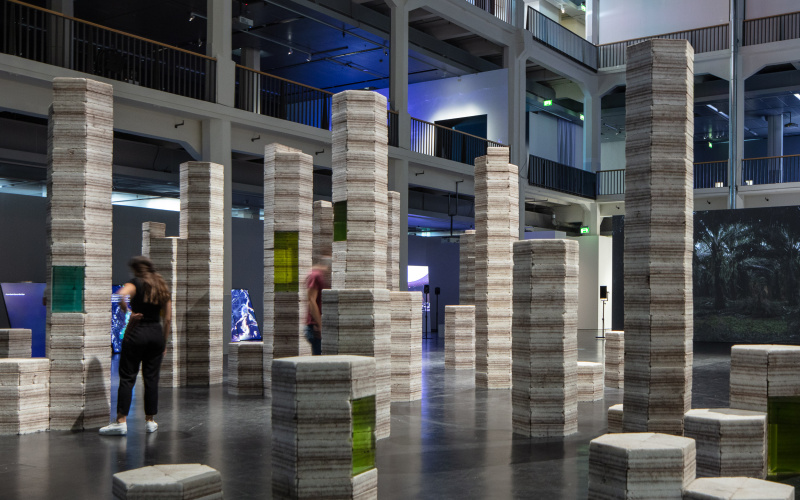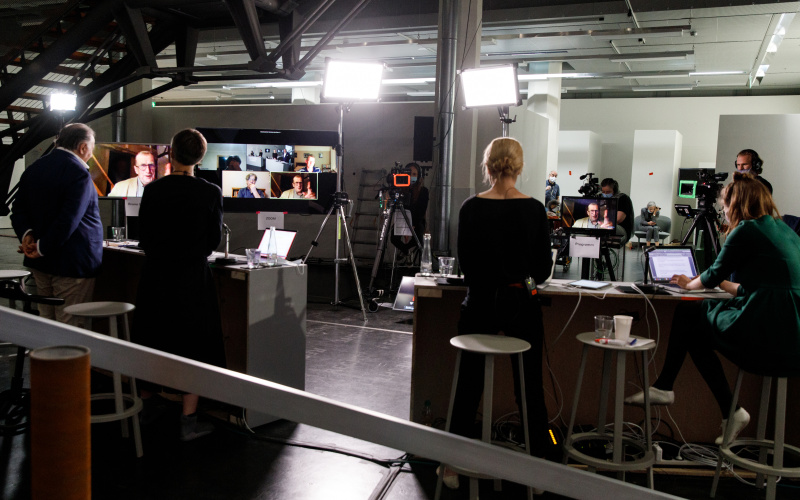The art of the review: Cartoon, cabaret, comedy
On the 300th anniversary of the city of Karlsruhe, the ZKM is planning a new Art Event over 300 days, which is dedicated to two important trends of the 21st century – namely globalisation and digitalisation and their effects on culture. These two trends evoke major irritation, not just in Germany.
Might it or can it be that a city with the name »Karlsruhe«, i.e. a city of quietness, is arousing the »quiet German«?[1]
Sociologists and philosophers discover a new formula or new title for the current state of the world at least once a month to express their anxiety, not to mention their despair. Whether risk society (Ulrich Beck, 1986), whether the overburdened society (Meinhard Miegel, Hybris. Die überforderte Gesellschaft, 2014), the fatigue society (Byung-Chul Han, 2010), post-democracy (Colin Crouch, Post-Democracy, 2004), the defective democracy (Wolfgang Merkel, 2003), or the shock doctrine (Naomi Klein, 2007), the world appears as a series of crises, from the climate crisis to the financial crisis, from the democracy crisis to the human rights crisis. Nevertheless, most societies are in a state of repression: They are solidifying, they are not moving, they are not changing, they are not acting. Agony and an inability to act on one side are inducing violence and terror on the other side. Some are observing the clash of civilizations (Samuel Huntington, 1993), if not the destruction of empires (Jared Diamond, Collapse: How Societies Choose to Fail or Succeed, 2005) or even a requiem for a species (Clive Hamilton, Requiem for a Species, 2010). The narrative of the end is turning from positive (Francis Fukuyama, End of History, 1992) to negative. The apocalypse, previously an argument of religion, is now an argument of science.
The BRICS states are still ascending, but no longer as strongly as predicted, some of the OECD countries are in a depression. The future of the European Union is uncertain and the USA continues to destabilise zones that are important in terms of economy and military. In these times of crisis and disquiet, a return to quietness is propagandised, a melancholy atmosphere, like Fernando Pessoa prescribed in his famous Book of Disquiet (2003) for loser nations, empires of former greatness.
However, we also know from history that black humour acts as therapy in times of sorrow. Whether in the form of »He who laughs last laughs longest« – jokes are not just characterised by their relationship to the unconscious (Sigmund Freud, Jokes and Their Relation to the Unconscious, 1905) but especially by their relationship to social tensions, protests and disruptions. At the historical instant, when the traditional critical and rational authorities and institutions of society are no longer able to fulfil their tasks adequately, another will take their place and take over their functions. The press was considered the fourth power in states, which critically observed and commented on the executive body, legislative power and judiciary. If the press becomes too conforming to the system, i.e. the manufacturing of consent (Edward S. Herman and Noam Chomsky, 1988) gains the upper hand, with which the »masses« should be aligned with the ideology of the elite, then erosions of the public sphere occur and appear, which endanger democracy. There occurs a frustration of both politics and the press. But however we learn from history, there are always counter forces. Today, the groups are made up of citizens and artists, who demand new forms of participation in political life.
The seismographic book of the hour could be by Peter Sloterdijk, i.e. Zorn und Zeit (2006 - Rage and Time). Dissatisfaction with the status quo of the world is accumulating all over. All institutions are affected by it: politics, religions, art, media. The dissatisfaction is expressed in public places, new zones of rage. Seemingly, the dissatisfaction of the masses can find no other place of articulation than the agora, the public gathering place. The public sphere like the people imagine it to be does not take place in parliament and the press, no longer in politics and the media. For this reason, the people return to classic publicity, the public place. Citizens find new media of rage.
Classic cartoons are also one of the new media of rage. It apparently awakens the rage of fanatical fundamentalists. The events in Paris and Copenhagen show that the target of rage is not the classic media of rage like art, politics and the press, but the fatal and lethal attacks target cartoonists. The attack on Charlie Hebdo on 07.01.2015 in Paris was not directed towards Le Monde or Libération, namely text media, but towards an image medium, an extremely critical satire magazine. The enemies of truth get most worked up by those things which show the truth. There is seemingly too much talk and not enough words in mass media. And what is said is not what is thought. It is typical for the state of our time that comedians, cabaret performers and cartoonists from Denmark to Paris are becoming the targets of attacks and threats. After cartoonist Kurt Westergaard was the focus back in 2010, the attack on 14th February 2015 in Copenhagen was directed at an event with cartoonist Lars Vilks. The power of pictures is greater than the power of the word. The sword of the word is losing against images and, for this reason, the real sword is being wielded against the creators of these images. We are experiencing how the text media is locking itself in a prison of its own wordings. People no longer find the echo of their thoughts in the forest of words. For this reason, they are looking for new places of truth, they are looking for refuge with the new heralds of the truth, namely comedians, cabaret performers and cartoonists. From John Stewart’s Daily Show to the heute-show by ZDF, we can see that cartoons and other forms of artistic hyperbolic, such as cabaret and satire are becoming the new media of truth and information, which are superseding the previous information media, like journalism. Occasionally, the accusation of the »lying press« is thrown out by people. This creates a tension between cartoons and religious fundamentalists, but also a rift, if not a trench, between cartoons and journalism. Instead of critical and investigative journalism uniting with the hyperbolic culture, a large part of the press criticises the comedians, rather than the reality that the comedians caricature. But the cartoonists have always made an appearance when radical social upheavals happened or conditions were no longer tenable in their dreariness and finality. Think about Honoré Daumier, Grandville, Gillray etc. When the world is particularly on its arse, then the bell tolls for cartoonists, cabaret performers and comedians.[2]
And seemingly, the bell is now tolling for cartoonists, cabaret performers and comedians. They are becoming established as new media of enlightenment and criticism. They are the intrinsic critical citizen.[3] We are experiencing a change of the public sphere, if we plagiarise Habermas (Strukturwandel der Öffentlichkeit, 1992). Cartoonists, cabaret performers and comedians are taking on some of the former tasks and functions of the press. They are performing the task of enlightenment with the press, alongside the press and, on occasionally, against the press. To some extent, the press is getting nervous because it is noticing that it is being surpassed in its critical analysis of the present crises and social wrongs by the cartoonists in terms of honesty and astuteness of knowledge. So for example, cabaret performer Frank-Markus Barwasser (alias Erwin Pelzig) showed a convincing diagram in the edition of Anstalt on 13.11.2012 which showed the personal connections between the Goldman Sachs bank and the high state financial centres throughout the world. A second diagram was produced by Pelzig in the 25.06.2013 edition on the subject of Gustl Mollath, which showed the amalgamation and interconnection of the people involved for the first time. Personally, I found out more from these diagrams than from so-called »serious” articles. In the name of humour, Hegel’s Cunning of Reason was created, namely to uncover the concealment and dislodgement, the repression and falsification of real conditions. Time and again, late at night in the cabaret programmes such as heute-show, Die Anstalt, Nuhr im Ersten, Extra 3, Quer, etc., you find on public television moments, in which the viewer becomes frightened by the truths that are presented, even though he is laughing. Even Henri Bergson lauded laughter as a medium of perception in his book Le rire (1900). For this reason, comedy, cartoons, cabaret are on the receiving end of extreme hostility by fundamentalists, who distort reality in their own interests.
Cabaret, comedy, cartoons seem to be joining the classic media of truth, like philosophy, art, science, press, as new media. The majority of art, the part that is discussed in the press, the marketable art, is considered a luxury product, a lifestyle accessory. It is not surprising that the masters of haute couture, such as Louis Vuitton and François Pinault are opening their own museums, be it in Paris or Venice, and even own their own auction houses (Christie’s is owned completely by Pinault’s Holding Artémis). The artists become suppliers of the luxury industry or the financial sector.
The attacks in the name of an Islamic fundamentalism have already triumphed insofar as they have poisoned the public sphere. Security measures are increasing, i.e. we are searched for weapons both at airports and also when entering restaurants, cinemas and museums, like in American schools. We are increasingly becoming victims because our freedom is being increasingly restricted.
In America, the phrase by Ben Bradlee, editor of the Washington Post, has held good to date: »We don’t print the truth. We print what people tell us. It’s up to the public to decide what’s true.« As a result of the terror act in Paris, the New York Times reported »Tastes, standards and situations change, and in the end it is best for editors and societies at large to judge what is fit – or safe – to print.«[4]Censorship is practised in the name of security. Enlightenment, criticism, truth are sacrificed at the altar of security. The old conflicts of darker times are breaking out again. Cartoons, comedy have already decided on what side they are fighting. The press is still relatively undecided. In this context, praise of the public service broadcasting authorities is deserved. They provide a systematic answer to the transformation processes of the public sphere. In the words of Luhmann, they grant a differentiation of the system. The cabaret and comedy programmes with political criticism form a type of subsystem, in which what is forbidden in the main system is permitted. Television is the most docile student of Talleyrand. Its system of wordings is the perfect adaptation of Talleyrand’s theory of language, which stated in 1807 in a modification of a sentence by Voltaire: »La parole a été donnée à l’homme pour déguiser sa pensée« [Speech was given to man to disguise his thoughts.] Voltaire said: »Les hommes ne se servent de la pensée que pour autoriser leur injustices et n’emploient les paroles que pour déguiser leurs pensées.« What the official news conceals or whitewashes or obscures through the wording is counteracted by the cabaret programmes that follow. These programmes say what the news is hiding. All the same, even in the system of conformism, television is allowing itself its own subsystem of non-conformism.
Due to this new state of the public sphere and because of these shifts, reversals and transformations of serious and non-serious forms of criticism, GLOBALE will host not only philosophers, theoreticians and artists, but also comedians, cabaret performers and cartoonists.
[1] George Packer, in: The New Yorker, 01.12.2014.
[2] Raimund Rüttgen (ed.), Die Karikatur zwischen Republik und Zensur: Bildsatire in Frankreich 1830 bis 1880, eine Sprache des Widerstands?, 1991, Oliver Watts, “Daumier and Replacing the King’s Body”, in: Anne Wagner, Richard K. Sherwin (ed.), Law, Culture and Visual Culture, 2014, P. 421–444.
[3] Pippa Norris (ed.), Critical Citizens. Global Support for Democratic Government, 1999.
[4] New York Times, 18.01.2015.
Category
News Category
- take a look… behind the scenes of ZKM



